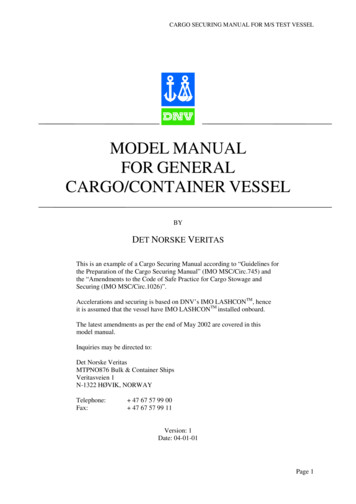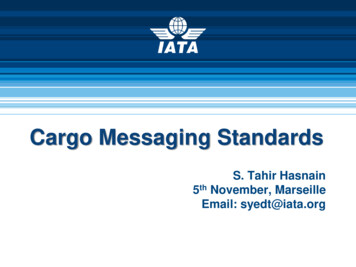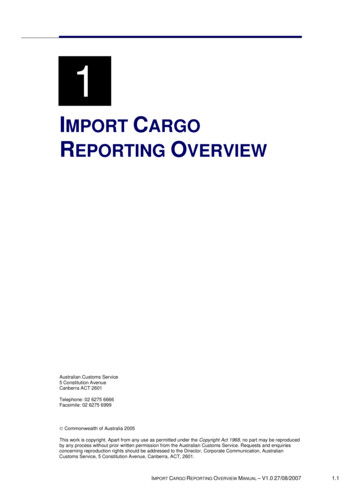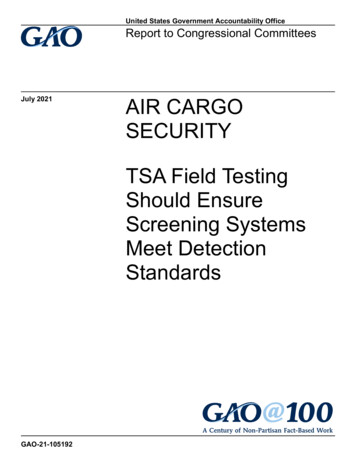
Transcription
CARGO SECURING MANUAL FOR M/S TEST VESSELMODEL MANUALFOR GENERALCARGO/CONTAINER VESSELBYDET NORSKE VERITASThis is an example of a Cargo Securing Manual according to “Guidelines forthe Preparation of the Cargo Securing Manual” (IMO MSC/Circ.745) andthe “Amendments to the Code of Safe Practice for Cargo Stowage andSecuring (IMO MSC/Circ.1026)”.Accelerations and securing is based on DNV’s IMO LASHCONTM, henceit is assumed that the vessel have IMO LASHCONTM installed onboard.The latest amendments as per the end of May 2002 are covered in thismodel manual.Inquiries may be directed to:Det Norske VeritasMTPNO876 Bulk & Container ShipsVeritasveien 1N-1322 HØVIK, NORWAYTelephone:Fax: 47 67 57 99 00 47 67 57 99 11Version: 1Date: 04-01-01Page 1
CARGO SECURING MANUAL FOR M/S TEST VESSELCargo Securing ManualforM/S TEST VESSELPage 2
CARGO SECURING MANUAL FOR M/S TEST VESSEL1Contents12Contents . 3General. 42.1 Ship Data. 42.2 Definitions . 52.3 General Information. 52.4 Principal sources of danger. 63 Securing Devices and Arrangements. 73.1 Specification of Fixed Cargo Securing Devices. . 73.2 Specification of Portable Cargo Securing Devices. . 73.3 Inspection and Maintenance Schemes . 84 Stowage and Securing of cargo . 114.1 Handling and safety instructions. 114.1.1General principles of cargo securing. 114.1.2Safe handling of cargo securing devices . 124.1.3Evaluation of forces acting on cargo units . 124.1.4Forces acting on typical cargo units . 144.1.5Calculation of forces in semi- and non-standardised lashing arrangements. 154.1.5.1MSLs for different securing devices154.1.5.2Safety factor154.1.5.3Simplified method – Rule of thumb154.1.5.4Ship Specific Example based on Alternative Method – using IMO LASCHONTM164.1.5.5Ship Specific Accelerations from IMO LASCHONTM194.2 Application of portable securing devices. 205 Supplementary Requirements for General Cargo/Container vessel . 215.1 Bulk Carriers. 215.1.15.2Extracts from various Timber Deck Codes . 21Container Carriers. 365.2.1Handling and Safety Instructions . 365.2.2Stowage and Securing Instructions . 375.2.2.1Stowage and Securing Plan (not included in this model manual)37Appendix I – Log for maintenance of cargo securing equipment. 38Appendix II – Manual procedure for calculation of lashings. 40Appendix III – Applicable Annexes from the CSS Code . 51ANNEX 6ANNEX 7ANNEX 8ANNEX 9ANNEX 11ANNEX 12Safe stowage and securing of coiled sheet steel. 51Safe stowage and securing of heavy metal products. 53Safe stowage and securing of anchor chains. 54Safe stowage and securing of metal scrap in bulk . 55General guidelines for the under-deck stowage of logs . 56Safe stowing and securing of unit loads. 58Appendix IV – LASHCONTM IMO USER GUIDE . 611 General. 621.1 Introduction. 621.2 System requirements . 621.3 User requirements . 622. User guide. 632.1 Input sequence. 632.2 Input data. 652.3 Calculation methods. 672.4 Special features of Lashcon IMO. 672.5 Program assumptions . 67Appendix V – Certification for fixed cargo securing devices . 69Appendix VI – Certification for portable cargo securing devices. 69Page 3
CARGO SECURING MANUAL FOR M/S TEST VESSEL22.1GeneralShip DataGeneral DataShip Name:DNV Id No:IMO No:FlagClass NotationM/S Test Vessel1234567890123Flag 1A1 General Cargo/ Container CarrierShip dimensionsLength, LppBeam, BDepth moulded, DDraft, TSpeed, VGM, range of values155.6 m21.0 m12.1 m7.0 m17.0 kn0.5 - 2.5 mReference documentsDocument/ManualLoading ManualTrim & Stability BookletIssue ge 4
CARGO SECURING MANUAL FOR M/S TEST VESSEL2.2Definitions“Cargo Securing Devices” is all fixed and portable devices used to secure and support cargo units.“Maximum Securing Load” (MSL) is a term used to define the allowable load capacity for a deviceused to secure cargo to a ship. “Safe Working Load” (SWL) may be substituted for MSL for securingpurposes, provided this is equal to or exceeds the strength defined by MSL.“Standardized Cargo” means cargo for which the ship is provided with an approved securing systembased upon cargo units of specific types.“Semi-standardized Cargo” means cargo for which the ship is provided with a securing system capableof accommodating a limited variety of cargo units, such as vehicles, trailers, etc.“Non-standardized Cargo” means cargo which requires individual stowage and securing arrangements.“Cargo transport unit” means a road freight vehicle, a railway freight wagon, a freight container, aroad tank vehicle, a railway tank wagon or a portable tank.“Fixed Securing Devices” means securing points and supports either integral, i.e. welded into the hullstructure, or non-integral, i.e. welded onto the hull structure.“Portable Securing Devices” means portable devices used for lashing, securing or support of cargounits.2.3General Information1The guidance given herein should by no means rule out the principles of good seamanship,neither can they replace experience in stowage and securing practice.2The information and requirements set forth in this Manual are consistent with the requirementsof the vessel's trim and stability booklet, International Load Line Certificate (1966), the hullstrength loading manual (if provided) and with the requirements of the International MaritimeDangerous Goods (IMDG) Code (if applicable).3This Cargo Securing Manual specifies arrangements and cargo securing devices provided onboard the ship for the correct application to and the securing of cargo units, containers, vehiclesand other entities, based on transverse, longitudinal and vertical forces which may arise duringadverse weather and sea conditions.4It is imperative to the safety of the ship and the protection of the cargo and personnel that thesecuring of the cargo is carried out properly and that only appropriate securing points or fittingsshould be used for cargo securing.5The cargo securing devices mentioned in this manual should be applied so as to be suitable andadapted to the quantity, type of packaging, and physical properties of the cargo to be carried.When new or alternative types of cargo securing devices are introduced, the Cargo SecuringManual should be revised accordingly. Alternative cargo securing devices introduced shouldnot have less strength than the equipment which it replaces.6There should be a sufficient quantity of reserve cargo securing devices on board the ship.Page 5
CARGO SECURING MANUAL FOR M/S TEST VESSEL7Information on the strength and instructions for the use and maintenance of each specific type ofcargo securing device, where applicable, is provided in this manual. The cargo securing devicesshould be maintained in a satisfactory condition. Items worn or damaged to such an extent thattheir quality is impaired should be replaced.2.4Principal sources of dangerSome important sources of danger which can affect the safety of roll on/roll off ships and of personson them include:1.Cargo badly stowed or inadequately secured inside or on cargo units.2.Free surface effects in tank vehicles, tank containers or other bulk units which are slack.3.Poorly maintained ramps, lifts and stern doors.4.Poorly maintained or inadequately illuminated decks.5.Wet decks.6.Failure to apply brakes correctly.7.Insufficient or incorrectly applied lashings or the use of lashing equipment of the wrong type orof inadequate strength with respect to mass and centre of gravity of the cargo unit and theweather conditions likely to be encountered during the voyage.Page 6
CARGO SECURING MANUAL FOR M/S TEST VESSEL3Securing Devices and ArrangementsWhen securing devices are replaced, the inventory lists should, as far as practicable, be updated andrelevant certificates inserted in an appropriate place in the manual.3.1Specification of Fixed Cargo Securing Devices.No other attachments to the ship hull structure than those listed below shall be made without theMasters special permission.Any lashing arrangements imposing loads exceeding the maximum securing loads listed in theinventory list may cause serious structural damage.Fixed securing devices:TypeManufacturerD-Rings“Lord of ng AS”3.2TypedesignationD-562TW-16-22QuantityMSL [kN]]1815048250SketchNot includedin this ModelManualNot includedin this ModelManualSpecification of Portable Cargo Securing Devices.As a general rule-of-thumb, if doubt about determining the MSL, portable equipment should not besubject to loads exceeding what have been customary usage in the past.Portable securing devices:TypeManufacturerLashing Chain“Chain Chain”Twistlock“Containersecuring AS”TurnbuckleLashing barTypedesignationB14804QuantityMSL [kN]15 x 2 m74.5TW-1-C112250“Containersecuring AS”TB-15-N48250“Containersecuring AS”LB-6-P48250SketchNot includedin this ModelManualNot includedin this ModelManualNot includedin this ModelManualNot includedin this ModelManualPage 7
CARGO SECURING MANUAL FOR M/S TEST VESSEL3.3Inspection and Maintenance SchemesRegular inspections and maintenance are carried out under the responsibility of the Master.Cargo securing device inspections should as a minimum include:1. Routine visual examinations of components being utilised:- Before using any cargo securing device, whether fixed or portable, the equipment must bevisually inspected to ensure that there are no defects and that when appropriate, all movingparts have been greased and are operating correctly.- After use, and before going into storage, each device should be visually inspected to ensurethat the device has not sustained damage, is still in good condition and does not requirerepair or replacement. Especially after heavy weather voyages the lashing equipment shouldbe carefully examined. Defective portable lashing equipment should be put aside into asuitable separate location, i.e. bins marked “BAD“, and any necessary repairs and testingmust be carried out prior to re-use. If beyond repair the equipment is to be scrapped.- Discarded parts of equipment should be replaced by equivalent parts. Cargo SecuringEquipment is only to be renewed by certified equipment.- All portable securing devices shall be visually examined and greased as necessary atintervals not exceeding 3 months.- Portable equipment not in use should be collected and stored in bins.2. Periodic examinations/re-testing as required by the Administration. When required, the cargosecuring devices concerned should be subjected to inspections by DNV.- The welds connecting the fixed cargo securing equipment to the ship’s structure should beinspected regularly and any fractures or tearing should be gouged out and rewelded. Weldingof the device to the structure should be carried out by approved personnel in accordance withrecognised welding practice.- If the underlying structure of the deck, tank top, hatch covers, bulkheads or side structure isdeformed to such an extent that an uneven stow would result, the structure should berepaired by the most appropriate method. Any significant deformation of the ship’s structurein way of securing points is to be reported to DNV at the earliest opportunity.- Cargo securing equipment used several times, both loose and fixed, should be re-testedregularly. The equipment to be tested should be selected by random selection, for instance 1of 50 pieces of each type of equipment. These tests should be to proof strength load.Page 8
CARGO SECURING MANUAL FOR M/S TEST VESSELThe following procedures should be followed for accepting, maintaining, repairing or rejecting cargosecuring devices, and should be carried out by the ship’s crew:Cargo Sec. DeviceInspection Check if/for:Elephantfoot potsdeformedcorrodedTurnbucklebentpins damaged or missinghook damageddestructive, threadlink is deformedLashing chainw/tensionerWire rope lashingsShacklesTwistlockBridgefittingpermanent kinksflatteningcorrosiondrying out of the fibre coreprotrusion of the fibre corebolt damaged or missingbentwear and tearhandle damaged/missingspring/ball/bolts and nutsdamagedamount of small cracksnuts damaged or missingbentdestructive; threadMaintenance* see belowActions to be:repaired or replacedreplaced if top plate is less than 75 % e if any link is deformedreplaced if any of the listed defects are found* see below* see newedscrappedrenewedstraightenedscrapped* Threads of turnbuckles, twistlocks and bridgefittings should be greased regularly, at least every 3months.Inspections and adjustments of securing arrangements during the voyage:1. The securing devices should be regularly inspected to ensure that the cargo remains safelysecured throughout the voyage.2. The securing arrangement should be adjusted, if found necessary after inspection, during thevoyage. Adjustment of securing devices include re-tightening of lashings or remaking thelashing. If necessary additional lashings should be fitted, and if possible the friction could beincreased. This is particular important when heavy weather or swell is expected. Moreover,when heavy weather has passed.Particular attention should also be paid to lashings which may become slack due to the cargodeforming or compacting during the voyage. Lashings may also become slack when cargoesare loaded and secured in conditions of low ambient temperature and the vessel then proceedsto areas of significantly higher ambient temperature.3. If adjustment to the cargo securing arrangement has to be carried out at sea under adverseweather and sea conditions adequate precautions have to be taken to avoid dangerous situationsfor the crew. Good seamanship is necessary.4. During a voyage, partial discharge may result in an exposed cargo face. This should preferablybe secured while loading to avoid hazards while discharging other cargo.Page 9
CARGO SECURING MANUAL FOR M/S TEST VESSEL5. Sufficient reserve securing devices should be carried to deal with unexpected circumstances.6. Entries of all examinations and adjustments to lashings should be made in the ship’s recordbook.Inspections and maintenance carried out are to be entered into the “Log for Maintenance of CargoSecuring Equipment“, see Appendix 1.Page 10
CARGO SECURING MANUAL FOR M/S TEST VESSEL4Stowage and Securing of cargo4.1Handling and safety instructions4.1.11.General principles of cargo securingCargo shall be secured according to recognised principles, taking into account the dynamicforces that may occur during sea transport and the most severe weather condition expected. Shiphandling decisions should take into account the type of cargo and stowage position of the cargoand the securing arrangements.- Care should be taken to distribute the forces as evenly as possible.- If in doubt the lashing arrangement should be verified using an acceptable calculationmethod.- The securing gear should be adapted to the cargo to be carried.- Lashings are to be kept as short as possible.2.Prior to loading cargo, the following should be checked:-3.Relevant deck areas are, as far as practicable, to be clean, dry and free from oil and grease.Cargo, cargo transport unit or vehicle to be suitable for transport.Necessary securing equipment is to be found onboard.See item 5.The securing equipment should be:-available in sufficient quantity including reservessuitable for the purpose**of adequate strength*practical and maintained*** The required strength, which depends on the lashing forces, can be calculated based onmethods for evaluating forces as outlined in this manual.** Specific handling and safety instructions are provided in sub-chapter 4.1.2 along withinstructions to suitable areas, while the maintenance are dealt with in chapter 3.3.4.Securing operations shall be completed before the ship leaves the berth and the securing shouldbe based on proper planning, execution and supervision. Relevant personnel should be properlyqualified and experienced and should have a sound practical knowledge of the application andcontent of this Cargo Securing Manual.- The master shall take care in planning and supervising the stowage and securing of cargoesbased on information about the cargo.- The cargo is to be distributed with attention to the ship stability so that the hazards ofexcessive accelerations are reduced as far as practicable.- Due attention to the ship’s structural strength should be taken.Excessive accelerations are expected to occur in the far forward and aft part of the ship, but canalso occur in general as a result of a high GM value.5.Where practicable, cargo units shall be provided with a Cargo Stowage and SecuringDeclaration, stating that the cargo has been properly stowed and secured, taking into account thePage 11
CARGO SECURING MANUAL FOR M/S TEST VESSELIMO/ILO Guidelines for Packing Cargo in Freight Containers or Vehicles. In general, cargocarried in containers, road vehicles, ship borne barges, railway wagons and other transport unitsshould be properly packed and secured within these units. Relevant expertise should be calledfor, if found necessary, when considering the shipment of a cargo with unusual characteristics,i.e. cargo which may require special attention to location, stowage/securing and weatherconditions.- Different commodities should be compatible with each other or suitable separated- Cargo must be suitable for the ship and vice versa6.If the duty officer considers that a cargo is not safely secured to a cargo unit, measures shall betaken to avoid shifting of the cargo. If adequate measures are not possible, due to the nature ofthe cargo or lack of securing points, the cargo unit shall not be taken on board. Reference in thisrespect is made to TfK Report 1990:6E “Loading and Securing Cargo on Load Carriers, Adviceand instructions”.7.The securing arrangements shall be adequate to ensure that there will be no movement whichwill endanger the ship. Slackening of the securing gear due to cargoes which have a tendency todeform or to compact during voyage shall be avoided. Cargoes with low friction coefficientshould also be tightly stowed across the ship to avoid sliding. Suitable material such as softboards or dunnage should be used to increase friction, ref. paragraph 7.2.1 of the CSS Code.8.Cargo units containing hanging loads (e.g. chilled meat, floated glass) and very high cargo unitsare, because of the relatively high position of the centre of gravity, particularly prone to tipping.Whenever possible they should be located in positions of least movement i.e. on the centre line,towards amidships and on a deck near the waterline.9.Safe means of access to securing arrangements, safety equipment, and operational controls shallbe provided and properly maintained. Stairways and escape routes from spaces below thevehicle deck shall be kept clear. The cargo spaces should be, as far as practicable, regularlyinspected during voyage.10.Lashings shall not be released for unloading before the ship is secured at the berth, without theMasters express permission.11.Cargo shall not obstruct the operating controls of stern doors, entrances to accommodationand/or fire fighting equipment.12.Dangerous goods shall be segregated, stowed and secured according to the IMDG code andvalid instructions for this ship.4.1.2Safe handling of cargo securing devicesThis subchapter should contain clear and specific handling and safety instructions for all the cargosecuring devices used on board. The instructions should be based on the manufacturer’s guidanceliterature. In order to be effective and simple to use, the instructions should be visualized by means ofsketches, figures or photos.4.1.3Evaluation of forces acting on cargo unitsLashing forces are derived from accelerations of the cargo due to ship motions. The largestaccelerations, and therefore the most severe forces, can be expected in the furthest forward, thefurthest aft and the highest stowage positions on each side of the ship. Special consideration should begiven to the securing of vehicles stowed in these positions. Generally the forces which have to bePage 12
CARGO SECURING MANUAL FOR M/S TEST VESSELtaken by the securing devices are composed of components acting relative to the axes of the ship, i.e.longitudinal, transverse and vertical direction. The two first are the most important to consider withrespect to lashing since the main function of lashings are to prevent cargo units from tipping and/orsliding, in the transverse or longitudinal direction.The transverse accelerations increase directly with the GM value, and care should be taken whenstowing and distributing cargo to avoid excessive accelerations, ref. sub-chapter 4.1.1 “Generalprinciples of cargo securing”.If cargo is stowed in positions where loads from wind pressure and/or sea sloshing may be expected,this shall be taken into consideration when securing the cargo.Due to uncertainties as to the actual weights and locations of the centre of gravity of cargo units, thelashing forces may vary considerably. It is not possible to specify exactly the maximum forces whichmay be exerted in the most severe conditions. A general rule is that an adequate number of lashings ofsufficient strength to meet the worst weather that could be encountered during the voyage shouldalways be fitted. If very heavy weather is expected, appropriate operational measures, such asdelaying sailing or altering course or speed, should be taken to minimise the forces.Due to the difficulty in predicting dynamic accelerations and the complexity of dynamic calculations,the lashing forces apply to rigid and unsprung cargo. Additional lashings will be required to resistdynamic forces due to sprung or non-rigid cargoes.The lashings are in general most effective on a cargo unit when they make an angle with the deck ofbetween 30 and 60 . When these optimum angles cannot be achieved, additional lashings may berequired.The forces can be estimated based on the calculation methods outlined in this Cargo Securing Manual.The effect of anti roll devices should not be taken into account when planning the stowage andsecuring of cargoes.Page 13
CARGO SECURING MANUAL FOR M/S TEST VESSEL4.1.4Forces acting on typical cargo unitsCargo units/cargo transport units on a ship will in principles be subjected to the forces given on thedrawing below.Source: Mac Gregor ConverPage 14
CARGO SECURING MANUAL FOR M/S TEST VESSEL4.1.5Calculation of forces in semi- and non-standardised lashing arrangementsWe have used IMO LASHCONTM for all the calculations in the Cargo Securing Manual for M/S TestVessel, and M/S Test Vessel have also IMO LASHCONTM installed onboard. As an alternative to useIMO LASHCONTM, a calculation procedure based on Annex 13 to the CSS Code and Amendments tothe Code of Safe Practice for Cargo Stowage and Securing (IMO MSC/Circ.1026) is included inAppendix II.4.1.5.1MSLs for different securing devicesMSLs for different securing devices are given in table 1 if not given else where.The MSL of timber should be taken as 0.3 kN/cm² normal to the grain.MaterialMSLShackles, deckeyes,50% of breaking strengthtwistlocks, lashing rods, Drings, stackers, bridge fittings,turnbuckles of mild steelFibre rope33% of breaking strength80% of breaking strengthWire rope (single use)Wire rope (re-useable)30% of breaking strength70% of breaking strengthSteel band (single use)Chains50% of breaking strengthWeb lashings50% of breaking strengthTable 1 - Determination of MSL from breaking strengthFor particular securing devices (e.g. fibre straps with tensioners or special equipment for securingcontainers), a permissible working load may be prescribed and marked by authority. This should betaken as the MSL.When the components of a lashing device are connected in series (for example, a wire to a shackle to adeckeye), the minimum MSL in the series shall apply to that device.4.1.5.2Safety factorWhen using balance calculation methods for assessing the strength of the securing devices, a safetyfactor is used to take account of the possibility of uneven distribution of forces among the devices orreduced capability due to the improper assembly of the devices or other reasons. This safety factor isused in the formula to derive the calculated strength (CS) from the MSL and shown in the relevantmethod used.CS MSL/safety factorNot withstanding the introduction of such a safety factor, care should be taken to use securingelements of similar material and length in order to provide a uniform elastic behaviour within thearrangement.4.1.5.3Simplified method – Rule of thumbThe total of the MSL values of the securing devices on each side of a unit of cargo (port as well asstarboard) should equal the weight of the unit. (The weight of the unit should be taken in kN).Page 15
CARGO SECURING MANUAL FOR M/S TEST VESSELThis method, which implies a transverse acceleration of 1g (9.81 m/s²), applies to almost any size ofship, regardless of the location of stowage, stability and loading condition, season and area ofoperation. The method, however, takes into account neither the adverse effects of lashing angles andnon-homogeneous distribution of forces among the securing devices nor the favourable effect friction.Transverse lashing angles to the deck should not be greater than 60 and it is important that adequatefriction is provided by the use of suitable material. Additional lashings at angles of greater than 60 may be desirable to prevent tipping but are not to be counted in the number of lashings under the ruleof-thumb.4.1.5.4Ship Specific Example based on Alternative Method – using IMO LASCHONTMInput to IMO LASCHONTM:LppBSpeedGM 155.6 m 21.0 m 17.0 kn 2.5 mCargo
CARGO SECURING MANUAL FOR M/S TEST VESSEL Page 1 MODEL MANUAL FOR GENERAL CARGO/CONTAINER VESSEL BY DET NORSKE VERITAS This is an example of a Cargo Securing Manual according to "Guidelines for










